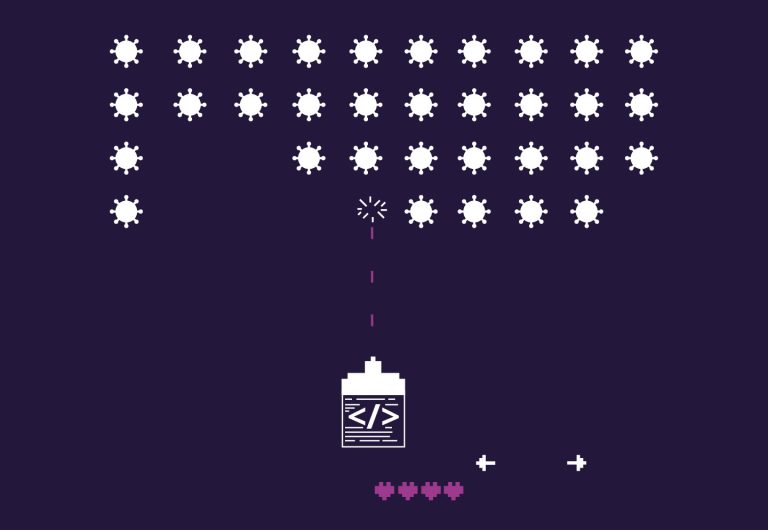Open Source in the Worldwide COVID-19 Battle

February marks the celebration of creation of the Open Source Initiative (OSI) in 1998. OSI created the standard definition of the term Open Source that helped guide many of LPI’s initiatives today. Through the past year, open source provided many opportunities to organizations to continue to work, implement their projects, and continue reaching out to communities. Here are just a few examples of how open source provides opportunities through the face of COVID-19.
This article is part of a monthly series on the LPI blog to celebrate the anniversaries of several key open source projects, by exploring different angles and directions of the broad open source movement.
The COVID-19 crisis brought out all the creativity of the open source movement. In every area of innovation–open source software, open data, open collaboration, and even open equipment–companies and research institutes have addressed medical and public health needs quickly. This article highlights some of the initiatives in each area.
LPI Partners Step Up
As part of a worldwide open source community, many LPI Partners have found opportunities through open source to pivot around the constraints of COVID-19.
- Sysvale Softgroup Tecnologia, a comprehensive computer service firm in Brazil, filled a major gap in public information by creating CO-VIDA, a crowdsourcing site where people can enter information about themselves and collectively put together a picture of where the virus has spread in the country.
- Consortium GARR in Italy added its open source eduMEET video conferencing software to a site called IoRestoACasa.work (“I Stay At Home”), which serves workers and students isolating themselves.
- Odoo, a management services firm with offices on three continents, offers its services for free to organizations in the COVID-19 campaign.
- Linuxhotel in Essen, Germany, which hosts training in free and open source software, made a transition to online courses.
Open Equipment
This may be the coolest development in the open COVID-19 campaign. Take ventilators, the final line of defense against death from the virus. Traditional ventilators are expensive, complex, and slow to manufacture. This is because they were designed to cover a wide range of uses and to be very robust; their adaptability and rich features make sense in normal times. But the millions suffering from shortness of breath due to a single virus could benefit from much simpler devices that get the job done.
- A ZDNet article lists several open source ventilator designs that can be used anywhere in the world to make devices that save lives. (ZDNet has done an excellent job covering COVID-19 related innovations. I discovered several of the projects in this article from their coverage.)
- INSPIRE, a project of the Polytechnic Institute of the University of São Paulo in Brazil, designs open-hardware ventilators and respirators.
- A team from Israel’s technology, military, and medical sectors collaborated on designs for low-cost ventilators aimed particularly at Africa.
- These DIY devices can be tested through software from the Ventilator Verification Project and monitored through https://www.pubinv.org/project/ventmon/ VentMon, both offered by https://www.pubinv.org/ Public Invention through the MIT license. Funding for these projecs was offered by the free software company https://blog.mozilla.org/blog/2020/05/06/mozilla-announces-the-first-thr… Mozilla, familiar for the Firefox web browser.
- Ventilators are not the only medical equipment with open designs. A https://www.zdnet.com/article/coronavirus-and-3d-printing-how-makers-are… ZDNet article describes several other types of equipment for which researchers are sharing designs.
Free Software
Although the healthcare field lags behind others in its willingness to use free software, a number of important tools have made headway. Open source electronic health records are employed in many countries.
- GNU Health, a major project of the Free Software Foundation’s GNU project, has worked with that city of Diamante in Argentina to deploy an app allowing the city to track suspected COVID-19 patients and their contacts.
- Germany deployed, under the Apache 2.0 license, a https://github.com/corona-warn-app contact tracing app that can warn people whether they have been exposed to COVID-19.
- An initiative of the Linux Foundation, Public Health, has released the code to two apps that help track COVID-19 infections and notify people at risk, Covid Green and COVID Shield.
- Two organizations providing important open source software in health care are i2b2 tranSMART (where the “tranS” stands for translational medicine, basically applied research), and Sage Bionetworks, which develops software for collaboration among pharmaceutical companies. We’ll see their contributions in other sections of this article.
- ICE is an open source tool providing clinical decision support for immunizations.
Open Data
It should be noted that open data is a messier and more nuanced topic than open source software. Even data that has been expertly deidentified (anonymized) is at risk of being re-identified, so it’s important to make sure that access to health data goes to legitimate researchers. Most organizations impose codes of conduct and licensing requirements to prevent abuses.
- In the United Kingdom, a number of companies and researchers worked with National Health Service to create OpenSAFELY with clinical data on 24 million patients, to help with COVID-19 research. Their software and code are available on GitHub, although I did not see a license.
- The COVID Tracking Project in the U.S., like CO-VIDA in Brazil, stepped in where the government has left a knowledge gap. A dedicated set of volunteers compile the latest public health data. And they do more than clean up and present the data: they also run it through two important analysis tools: COVID Racial Data Tracker and the Long-Term-Care tracker. This project is supported by The Atlantic magazine and has published its data and content under a Creative Commons CC BY 4.0 license,
- The COVID Care Map offers geospatial tools to look up who’s getting or not getting equipment, and how strained is the capacity of a region’s providers. The open source Nextstrain SARS-CoV-2 Research tracks the evolution of the virus–a major concern because it is quickly producing more deadly mutations.
- Sage Bionetworks has created a National COVID Cohort Collaborative Data Enclave with data from the U.S. National Institutes of Health (NIH). This open database is at the heart of a COVID-19 DREAM Challenge.
- Terra, an open source database for health formed by Alphabet’s Verily and the Broad Institute, provides data to help researchers see the spread and mutations of COVID-19. Because the Broad Institute is in the Boston area, this partnership helped to uncover what was probably the first COVID-19 super-spreader event in the Western hemisphere. (I remember it well, as I also live in the Boston area.)
- data.world’s open data community promotes collaboration on COVID-19 by asking organizations to share their data using the Creative Commons Open License.
- A ZDNet article includes a huge list of other data sets available to COVID-19 researchers.
- Several of the projects listed here are also curated in the more extensive Data4Covid19 Repository of The Governance Lab at New York University (NYU). (I do freelance writing and editing for The GovLab.) Stefaan G. Verhulst, Co-Founder of The GovLab, when interviewed for this article, said “Open source, like open data and open science, enables radical collaboration and experimentation to address mission-driven public interest goals in a much more agile and cost-effective manner.”
Open collaboration and other help for researchers
All manner of resources have been opened up by generous organizations in the effort to research COVID-19: tools for searching papers, locating their authors, and analyzing the data.
- COVID-Net offers a tool developed through machine learning for determining the presence of COVID-19 from chest X-rays. It was created with support from The Governance Lab.
- Kaggle, a collection of datasets for data science, created a COVID-19 Open Research Dataset (CORD-19) containing more than 280,000 scholarly articles, and ran a research challenge with the data sets. An article from the U.S. National Institutes of Health describes the content, which seems to be only text and metadata, but not the actual data used by the scholars.
- Verizon’s Vespa is another open-source tool (released under the Apache 2.0 license) that helps in searches and recommendations for relevant articles in health care.
- Three COVID-19 projects at i2b2 tranSMART are in early stages; one intriguing project helps people locate researchers they may want to collaborate with.
- Finally, one must not forget that researchers need heaps of compute resources to run their analytics. Early in the history of the pandemic, therefore, the U.S federal government persuaded 16 laboratories and companies to offer free compute time to COVID-19 researchers.
The COVID-19 Campaign Brings a Breath of Fresh Air
The initiatives in this article hopefully point to an opening up of the healthcare field, which traditionally has been conservative and reluctant to share data or collaborate. The pandemic has brought new urgency to criticisms that have been aired for decades: lack of coordination in providing life-saving equipment, rigid publication practices that hold up research or charge high prices for it, poor practices in data collection and sharing, and use of inflexible data formats such as spreadsheets. And of course, people worry about who’s getting our data and how they might abuse it.
The terrible toll of COVID-19 has sped up traditional processes–such as the amazing development of vaccines–and forced the healthcare field to adopt practices such as telehealth that it should have embraced long ago. Hopefully, the new collaborative environment will also break the logjam of siloed data and behavior that has increased health care costs and slowed moves to better practices such as value-based care. Sunlight is the disinfectant the field needs now.
